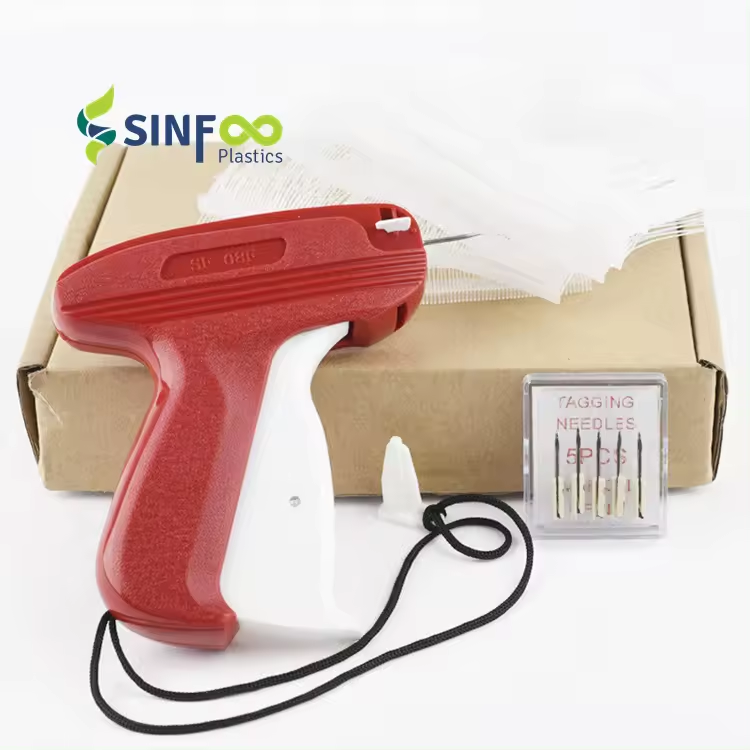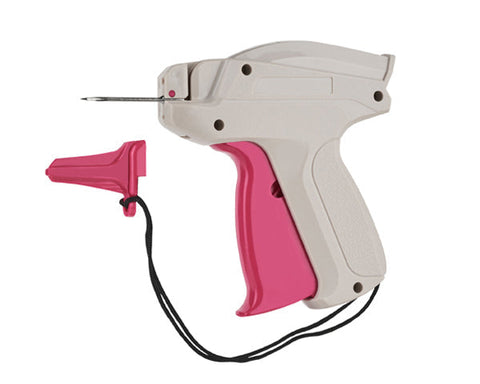小売業に革命を起こす: 効率的なラベル付けのためのトップタグガンとアクセサリ

タグガンを理解する: 小売業に必須のツール
タグガンの基本とその仕組み
タグ ガンは、小売店で素早くラベルを貼る際に欠かせないツールです。細い針とプラスチックの留め具を使って商品にタグを取り付けます。基本的な手順は次のとおりです。
- とげのあるプラスチック留め具のストリップを使用して銃を装填します。
- 針をタグとアイテムに挿入します。
- トリガーを握って留め具を外し、取り付けます。
- タグをしっかりと固定したまま、針を引き抜きます。
スピードと効率を向上させるシンプルなツールです。
タグガンの種類:長所と短所
- 標準タグ ガン: 小売業で最も一般的なタグ ガンで、アパレルやソフト グッズに値札、サイズ マーカー、在庫管理タグを取り付けるために使用されます。手頃な価格で使いやすく、広く入手可能です。ただし、繊細な生地には適していない場合があります。生地を傷める可能性があるためです。
- ファインファブリックタグガン: 繊細な素材向けに設計されたこれらのタグガンは、生地へのダメージを防ぐために、より細い針と柔らかいタックを使用しています。ブティックや高級衣料品を扱う店舗に最適ですが、標準的なタグガンよりも高価になる場合があります。
- 空気圧タグ ガン: これらのタグ ガンは空気圧縮機で駆動され、迅速なタグ付けが可能です。大規模な作業には非常に効率的ですが、空気圧縮機が必要で、手動タグ ガンよりもコストがかかります。
- 安全タグ ガン: 偶発的な怪我や商品の損傷を防ぐためのメカニズムが含まれています。安全性と製品の完全性を確保するのに優れていますが、標準的なタグ ガンよりも使用に少し時間がかかる場合があります。
タグ ガンの各タイプには独自の目的があり、小売業者は長所と短所を比較検討して、ニーズに合った適切なものを選択する必要があります。
小売業者に必須のタグガンアクセサリ
効率的なラベル付けにおけるタグガンピンの役割
タグ ガン ピンは、迅速かつ安全なラベル付けに不可欠です。この細くて鋭い物体は、商品に値札を取り付けます。さまざまな長さとスタイルがあり、それぞれ異なる素材や製品に適しています。正しいピン タイプを使用すると、タグがしっかりと固定され、生地が安全になります。小売業者は、さまざまなタグ付けのニーズを満たすために、さまざまなピンを在庫する必要があります。適切なピンを使用すると、タグ付けが効率的になり、労力が減り、時間が節約されます。
さまざまな生地に適したタグガン針の選択
さまざまな生地に適したタグガン針を使用することが重要です。次の点に留意してください。
- 細い針は、シルクや上質なリネンなどの繊細な素材に最適です。素材の損傷を防ぎます。
- 標準の針は、綿や合成繊維を含むほとんどの生地に適しています。
- 頑丈な針は、デニム、キャンバス、革などの厚くて密度の高いアイテム用に作られています。
- 先細りの針は引っ掛かりを最小限に抑えるのに役立ち、編み物や織物に適しています。
- 使用する前に必ず針のサイズと形状を確認してください。生地の種類に合ったものでなければなりません。
- タグ付けをスムーズにし、生地の損傷を防ぐために、定期的に針を交換してください。
適切な針を選ぶことで、商品を傷つけることなく、きれいなタグの取り付けが可能になります。
効率を最大化: タグガンの使用に関するヒントとコツ
小売店でのタグガン使用のベストプラクティス
小売店でのタグガンの使用を最適化するには、いくつかのベストプラクティスを習得することが不可欠です。
- 準備が鍵:タグと付属品を事前に整理します。これにより、ラベル付けの時間を節約できます。
- 一貫したテクニック: 毎回同じ手の位置と圧力を使用します。これにより、高速で均一なタグ付けが保証されます。
- タグの配置: 商品の標準的な場所にタグを配置します。これにより、顧客がタグを見つけやすくなります。
- スタッフのトレーニング: チームメンバー全員がタグガンの正しい使い方を理解していることを確認します。これにより、ミスや事故を回避できます。
これらの簡単な手順に従うことで、タグ付けのプロセスがよりスムーズかつ効率的になります。
メンテナンスと安全性: タグガンを最高の状態に保つ
タグ ガンをメンテナンスするには、次の簡単な手順に従ってください。
- 摩耗した部品がないか定期的に点検してください。
- 使用後は毎回、銃に付いた糸くずやほこりを取り除いてください。
- 乾燥した安全な場所に保管してください。
- 生地に応じて適切な針とピンを使用してください。
- 使用および取り扱いについては製造元のガイドラインに従ってください。
- 針が鈍くなったり曲がったりしたら交換してください。
- 損傷を防ぐために銃を落とさないようにしてください。
適切な手入れを行うことで事故を防ぎ、タグガンの寿命を延ばすことができます。
関連記事:



